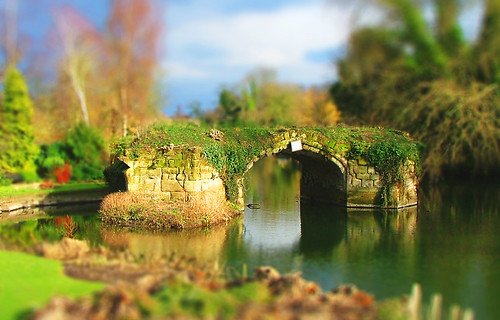To add good miniature effect to your photographs, shoot subjects from a high angle (especially from the air). It creates the illusion of looking down at a miniature model. A camera equipped with a tilt-shift lens, which simulates a shallow depth of field, is essentially all you need to start.
EXAMPLES:

Model Bridge Regular photo made to look like a miniature model using the 'Shift Tilt' or 'Fake Depth of Field' effect.
The photo is of a bridge by the Mill & Engine House at Warwick Castle

Fake Miniature, Dubrovnik
BIG ONOFRIO'S FOUNTAIN
Located at the open space right to Pile gate. It is a 16-sided drinking fountain built by Onofrio de la Cava (1438 - 1444). The Fountain is part of the town's water supply system which Onofrio managed to create by bringing the water from the well in Rijeka Dubrovacka. The well is located 20 km from Big Onofrio's Fountain and this construction was a masterpiece of that time.
SLIDESHOW OF THE GROUP FOTOSHOP TILT- SHIFT
CAMERAS USED FOR TILT-SHIFT,, LANDSCAPE AND ARCHITECTURE PHOTOGRAPHY
The Canon TS-E 24mm f/3.5 L Tilt-Shift Lens is (update: before 2009) Canon's only L Series Tilt-Shift lens. It is a great choice for architecture and wide landscape photography.
What is a Tilt-Shift lens? Good question. While many large format system users are familiar with the concept, I hazard to say that most 35mm format users are not.
Canon's Tilt-Shift lenses feature three not-found-on-a-typical-lens adjustments. Tilt, Shift AND Rotate. These adjustments can be used individually or simultaneously to alter the relationship of the optical axis of the lens to the sensor (or film) plane.
Tilt. Turning the small (too small) tilt adjustment knob angles the lens up to +/- 8 degrees relative to the sensor plane. The result is a plane of sharp focus that is not parallel to the sensor plane. The plane of sharp focus follows the direction of the tilt of the lens. For example, tilt the Canon TS-E 24mm f/3.5 L Tilt-Shift Lens downward to keep an expansive area of relatively flat ground in focus from close out to infinity even at a wide aperture setting. Actually, the plane of sharp focus becomes more like a focus wedge as the DOF (Depth of Field) increases with distance.
Use this feature to selectively keep objects in or out of focus in the picture. It is surprising how much background blur a relatively slow (f/3.5) 24mm lens can produce when tilted significantly. Diffusely blur the non-subject portion of your picture to dramatically direct the viewer's eye to the subject. The tilt adjustment scale is marked in 1 degree increments. The amount of change in plane of sharp focus at the maximum tilt settings is significant. Many of the sample pictures show maximum tilt.
MORE INFORMATION: http://media.the-digital-picture.com/Information/Canon-Tilt-Shift-Concepts.pdf
.




No comments:
Post a Comment